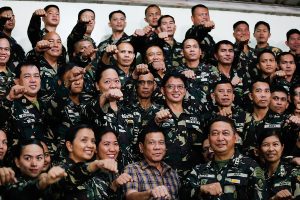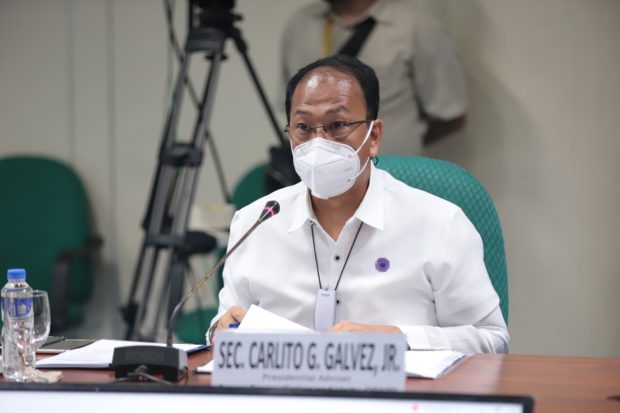Recently, Philippine Defense Secretary Delfin Lorenzana signed an order renaming the titles of the key officials of the Armed Forces of the Philippines (AFP). In his words, the change will help the AFP to
“keep in step” with other military organizations, and it is also expected to change the military structure to one that is
“more responsive to current and future non-conventional threats.” Nevertheless, such a vision could remain a distant goal if there are no structural reforms beyond the changing of titles.
The AFP was established following the passage of
Commonwealth Act No. 1, also known as the National Defense Act of 1935. For almost 85 years now, this law has remained the legal basis for the AFP’s existence, mandate and even strategy. Though specific provisions of the law were rescinded by presidential decrees or executive orders, especially during the time of President Ferdinand Marcos, and different Department of National Defense (DND) department orders have been published over the years, the act itself has yet to face Congress’ meticulous legislative deliberations.
It is worth noting that this law is not just obsolete — it was passed during the Commonwealth period, where the United States had not yet given the Philippines full independence. The framers of the act expected that the American military would still be there to defend the Philippine Islands. Such an appreciation for the U.S. military can even be interpreted from the provision that the Philippine president can appoint a U.S. army officer as a technical adviser known as a field marshal.
General Douglas MacArthur held this position until the start of World War II.
Army-Dominated Military EstablishmentEven without discussing each provision in detail, it’s fair to say that this law does not equip the AFP with the ability to respond to either invading states or non-traditional security threats of the 21st century. However, beyond that, this unchanged defense act has another problem: it institutionalized the importance of ground forces in territorial security. Since 1935, the Philippine Army (PA) has dominated the entire defense establishment. Though other factors helped establish the PA’s leading responsibility, particularly the communist insurgency, secessionist
Moro rebels, and now terrorism, it is essential to highlight that the PA has borne nearly the entire burden of national defense since the establishment of the AFP.
While the other branches of the military service were established in
1947, and the AFP was reorganized in
1950 through the issuance of presidential executive orders, the military was still largely dominated by the PA — not just in terms of leadership but also in fiscal support and even in terms of the size of its ranks. This was justifiable and accepted among the other services during the Cold War, given that the threat of communist insurgency was a primary concern at the time. Furthermore, since the U.S. 7th Fleet was stationed in Subic Bay and Clark Air Base hosted U.S. Air Force fighter planes, the army-dominated AFP chain of command saw the PA as the one military service the U.S. was not able to replace. Even if a meager budget was allotted to the Philippine Navy (PN) and the Philippine Air Force (PAF), with fewer sailors and airmen, it was expected that the U.S. would deter or subdue any external security threat.
However, when the geopolitical dynamics shifted after the Cold War, the U.S. bases were no longer permitted to stay in the Philippines. When the Americans left, it revealed the Philippines’ poor external defense capability, particularly with regards to the PN and the PAF. This was exposed when the Chinese took over the
Philippine-occupied Mischief Reef in 1995. Such an incident could have been the turning point for lawmakers to reassess and evaluate the antiquated law that outlines the Philippines’ national defense structure. Instead, President Fidel Ramos pushed for the
AFP Modernization Act, which laid out a 15-year plan for defense capability acquisitions for the PN, PAF and PA. However, due to the Asian financial crisis, military modernization was set aside, and once again, the American military was welcomed through the
Visiting Forces Agreement in 1998.
Incidentally, during the near-decade-long term of Gloria Macapagal Arroyo, there was no emphasis on revising the National Defense Act or modernizing the PN and PAF. The military has persistently been dominated by the PA, with 11 of Arroyo’s chiefs of staff coming from the army. Though an air force general was appointed on one occasion, he retired after barely three months in office. During the Arroyo administration, the AFP focused on counterinsurgency operations against the Moro rebels in Mindanao, which remained the justification for the army’s significant cut of the defense budget. Interestingly, Arroyo openly relied on retired army generals, who dominated her cabinet during her presidency.
Under Benigno Aquino, however, the guidance for the military was to concentrate on
external defense and not on internal security operations. China’s aggressive behavior in the South China Sea could have been an opportunity to call for Congress to reevaluate the obsolete National Defense Act, but Aquino pushed for the extension of the AFP Modernization Act instead. Though this became an excellent opportunity for the PN and PAF to realize their shopping list, some acquisitions never materialized. A case in point is the
scrapping of the shore-based missile system (SBMS) in favor of purchasing individual combat equipment like helmets, night goggles, body armor and radios, among other things. The change was supported by Aquino.
For the current president, Duterte is replicating Arroyo’s political playbook, which is relying on retired army soldiers to form part of his cabinet. On the other hand, he recognizes the importance of modernizing the AFP by supporting the acquisition of military assets for the PN and PAF. But the army’s sway has remained strong. In 2018, his defense secretary, a retired army general, approved the creation of a single army
division that is estimated to be composed of 4,500 personnel, which is almost one-third of the troops of either the PN or PAF. And the top military positions remained a revolving cast of army generals.
Hitches of the National Defense Act of 1935The biggest downside of Congress’ failure to amend the existing National Defense Act of 1935 is the Army’s entrenched domination within the AFP. The act’s focus on the ground forces gave the PA leeway to consistently position itself as the entire military organization’s strategic leader. Its ability to adapt to various developments involving the country’s strategic environment has made the army a domineering actor in setting policies that work to its own advantage, whether that concerns the budget, personnel complements, or even the acquisition of assets.
Looking at the AFP’s annual allocation, the most significant portion of
defense spending still goes to the army, which accounts for almost half of the entire budget. Despite the clear and present danger beyond the Philippines’ shorelines, the PA still managed to convert the acquisition of missile systems into purchases of helmets. The overused argument that the army’s main contribution is countering insurgency and separatist movements is not convincing — those problems have never ended, despite the overwhelming focus on them.
In terms of troop size, it is worth mentioning that out of the
140,000-strong AFP, almost 100,000 troops serve in the army. Just about a quarter of troops are from the PN, which includes the Philippine Marines, and PAF. While other countries are building their navy and air force by training more sailors and pilots, the PA remains the priority for additional personnel quotas. In 2019, Duterte stated that the AFP needs an
25,000 additional soldiers to fight insurgency and terrorism; it can be assumed that a significant portion of these recruits will be given to the PA. Moreover, it is worth noting that the PA has an additional force multiplier through the Citizen Armed Force Geographical Unit (CAFGU) Active Auxiliary Service, whose manpower is estimated to number around 60,000.
Likewise, chances remain slim of officers from the PN or PAF being granted the position of chief of staff. Currently, this serves as a
sinecure for loyal army generals, and a means of incentivizing the AFP to remain loyal to the commander-in-chief. This was a strategy adopted by previous administrations, and it still pertains today. The failure of the National Defense Act to govern the particular term and selection of the military chief has allowed patronage politics to influence its leadership.
Lastly, though the PN and PAF are both prioritized for modernization efforts, it is evident that the PA is still able to lobby to alter some of the items in the procurement list. As explained, this is made easier since the PA and its senior commanders have direct access to power — currently, army generals serve as both the chairman of the joint chiefs and the defense secretary.
Policy RecommendationsIt is about time for the Philippines to enact a new law for national defense, not just to be in tune with the contemporary threats it faces, but to push through reforms that de-institutionalize the domination of one branch of service within the military. The issue of fair budget distribution, rational programming of personnel increases and even strategic acquisition of assets could all be addressed by the passage of a new law. Congress could include specific provisions to evaluate the needed percentage distribution of the defense budget, subject to review every three or five years. Nevertheless, the most important upshot of a new law would be that Congress could limit the overarching supremacy of the army within the AFP. Furthermore, the new law could establish fixed term limits for the chairman of the joint chiefs and even introduce the requirement that the post should rotate between the three branches of the military. This setting could give equal opportunity for all the branches of the military to be represented at the upper echelons of command.
If a new defense act is not enacted soon, the PAF might have to compete with the growing Army
Aviation Regiment to acquire aircraft, and the PN may be forced to wrestle with the Army
Riverine Unit for fast boat procurement. Obviously, these army initiatives are not intended to strengthen the AFP’s capability as a whole, but are another pliable strategy for the PA to contend for limited resources with the Air Force and the Navy. Duterte’s enormous support in the Congress would undoubtedly let him pass a new defense act should he ask for an urgent bill — just look at how quickly the Philippine
anti-terror law was enacted. However, with
retired army generals surrounding him, it is difficult to tell whether a new defense act can be realized before Duterte ends his term in 2022.
[Jay Tristan Tarriela is a Philippine Coast Guard officer and is currently on study leave. He is a Ph.D. candidate and a Japan International Cooperation Agency (JICA) scholar at the National Graduate Institute for Policy Studies (GRIPS) under the GRIPS Global Governance (G-cube) Program in Tokyo, Japan. He is also a Young Leader with Pacific Forum, Honolulu. All views expressed in this article are his own and do not necessarily represent the official stand of any particular institution.]https://thediplomat.com/2020/09/why-the-philippines-needs-to-revise-its-national-defense-act/
























